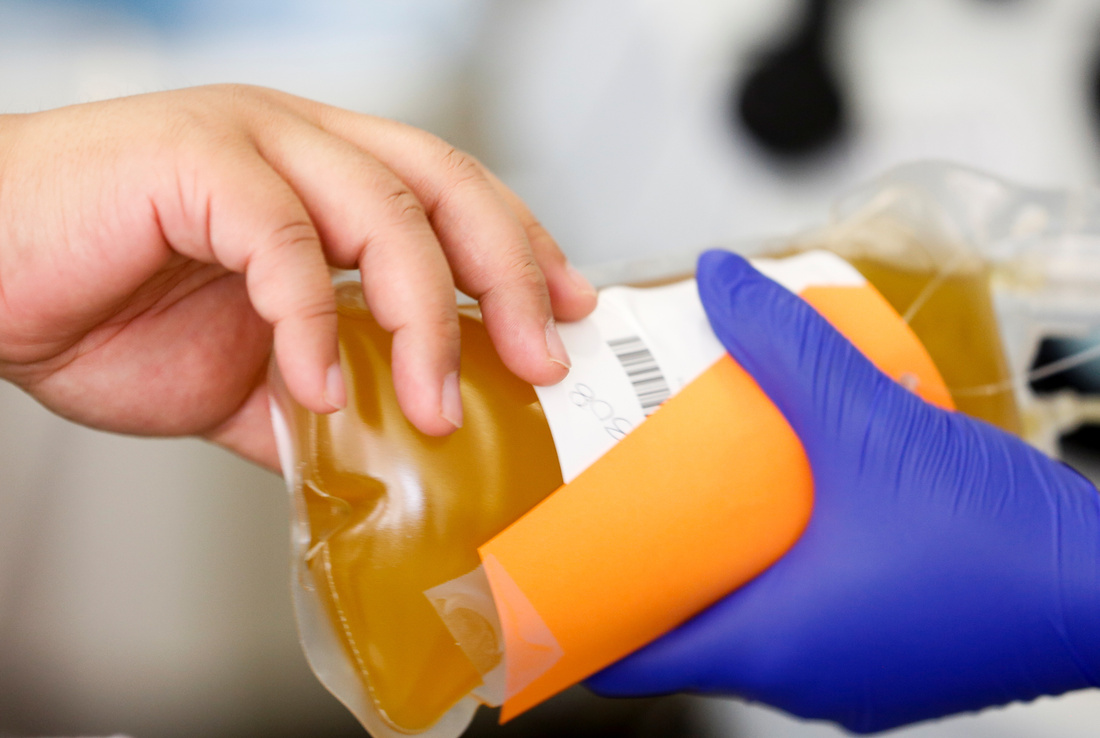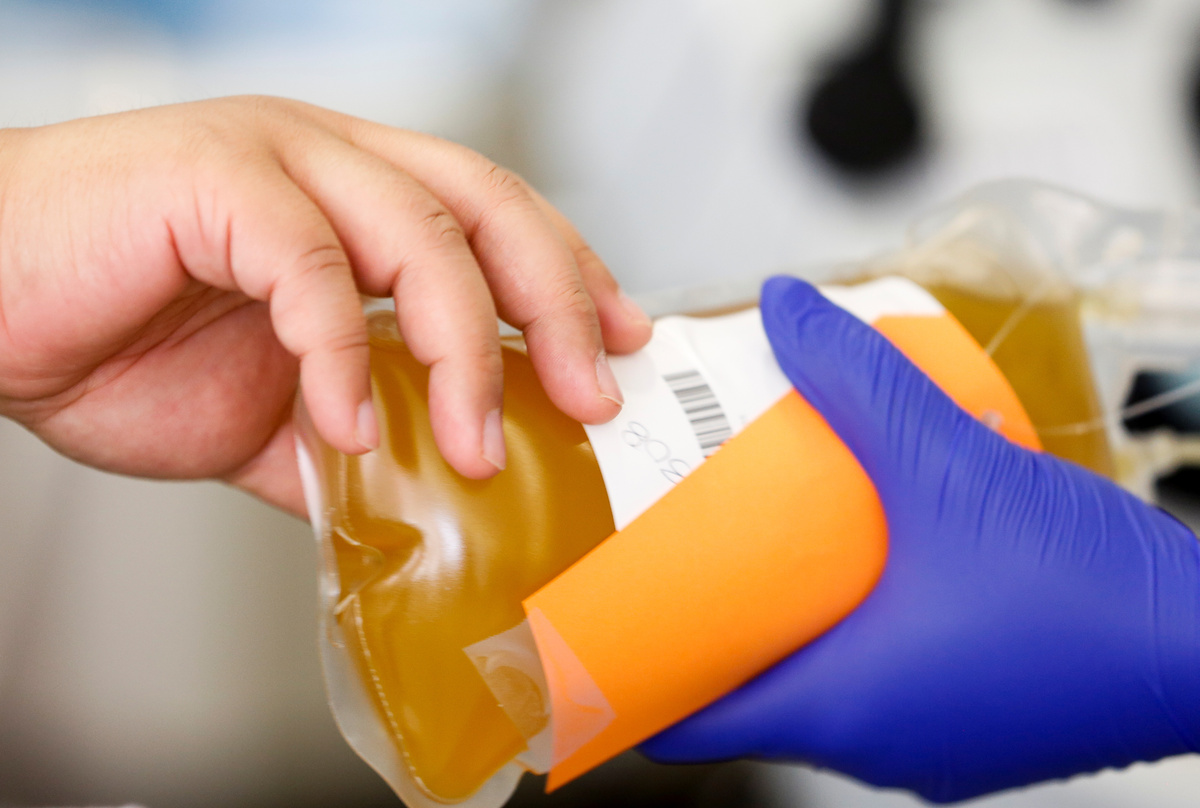Antibodies From Recovered COVID-19 Patients Being Tested As Way To Prevent Infection : Shots

Blood plasma — the yellowish, cell-free portion that remains after red and white blood cells and have been filtered out by a machine and returned to the plasma donor — is rich with antibodies. Plasma from recovered COVID-19 patients might prove useful in preventing infection as well as in treatment, scientists say.
Lindsey Wasson/Reuters
hide caption
toggle caption
Lindsey Wasson/Reuters

Blood plasma — the yellowish, cell-free portion that remains after red and white blood cells and have been filtered out by a machine and returned to the plasma donor — is rich with antibodies. Plasma from recovered COVID-19 patients might prove useful in preventing infection as well as in treatment, scientists say.
Lindsey Wasson/Reuters
If you’re bitten or scratched by an animal with rabies, your doctor can give you a shot to prevent the virus from taking hold in you and causing an infection. The same concept is now being put to the test for the coronavirus.
Most people who get sick with COVID-19 produce antibodies in their blood that seem protect them from re-infection. A study is now underway to see whether an infusion of those antibodies can protect someone who has been exposed to the virus and is at high risk of infection.
One of the first volunteers for this study is a physician who treats transplant patients at the Johns Hopkins University School of Medicine. Jonathan Orens had a close brush with coronavirus, involving not his work, but his family.
His daughter from Los Angeles wanted to come home to be near her sister, who was about to give birth to her first baby. Orens says the traveling daughter was careful about protecting her health in Los Angeles, and did everything she could think of to stay safe on her flight to Baltimore.
“She wore a mask, she wore gloves, she had sanitizer, she had wipes,” he says. “The load on the plane was relatively small.” They chose the Fourth of July as a travel day, knowing that even fewer people were likely to be traveling that day. “We actually bought the two seats in the row to keep her away from everybody else.”
She wore masks through the airports and in the car ride back to her parents’ house. Once there, she kept her distance from them.
Just to be sure, about a week after she arrived, she and her parents went for coronavirus testing.
Though she had no symptoms, “she was positive,” Orens says. “And fortunately my wife and I were negative.” But they were still at high risk of contracting the disease, given the close contact with their daughter.
As luck would have it, one of Orens’ colleagues at Hopkins was just starting a study to see if purified blood serum from people who have recovered from COVID-19 — called convalescent plasma — could prevent the disease in someone else. Orens and his wife, who are in their early 60s, are entering an age group at higher risk of serious disease if infected with the coronavirus. They signed up for the experimental treatment.
Half the people in this clinical trial get an intravenous infusion of convalescent plasma, while the other half get an infusion of blood serum that had been donated before the pandemic emerged (so lacked protective antibodies). Neither the participants nor the doctors treating them know who’s getting what.
The infusion took about an hour, Orens says. “I didn’t feel anything except for the pinprick from the IV, and we went on our merry way.”
He now returns to the clinic for regular blood tests.
“We’ll follow him along to see if he develops symptoms and if he turns positive,” says Dr. Shmuel Shoham, who is directing the study. Shoham says he plans to enroll up to 500 patients — though, in the best-case scenario, if the treatment is highly effective he won’t need to study that many people.
In addition to recruiting patients in Baltimore, “right now we have sites in Houston, sites in Alabama,” Shoham says. “We’re opening up additional sites in Dallas and Arizona. We have sites all over Southern California.”
He’s also involved in a second study that looks at whether plasma will prevent serious illness in people who are infected but not sick. He says if both of these strategies work, they could help a lot of people, even in the absence of a vaccine.
“That would give people a lot of confidence, I think to go back to school, go back to work,” he says, “because if somebody gets sick it’s not a tragedy –because we can protect them and protect those around them.”
These studies are among a growing number of experiments involving convalescent plasma, both as preventive measures and as treatments for COVID-19.
Dr. Jessica Justman at Columbia University’s Mailman School of Public Health in New York tried to launch a similar study this spring. Good news for New York – but a complication for her study – was that the disease had largely abated in the city, and she didn’t have luck recruiting people to participate.
“Compared to March and April, people have become less worried, less scared of COVID and perhaps a little bit less inclined to go for a preventive treatment,” Justman says.
That situation could turn around if the disease roars back in her area. And Justman says the idea is well worth pursuing. A similar strategy works against other diseases – not just rabies, but hepatitis B, botulism and a potentially serious viral infection in babies, called respiratory syncytial virus. In fact, this general strategy dates back more than a century. Shohan was involved in a study that attempted to use convalescent serum to treat the flu, and it was not successful — so it isn’t a cure-all.
Piggybacking on this strategy, drug companies are gearing up to manufacture antibodies, instead of collecting blood from recovered patients. But those products — monoclonal antibodies — wouldn’t be cheap.
“What I like about the convalescent plasma idea is that if it worked, I see it as something that could really be scalable in resource-limited settings,” Justman says, referring to developing countries where expensive pharmaceuticals are frequently out of reach. “And I think that’s where convalescent plasma has this really great potential.”
As for the Orens family, nobody fell ill — whether that was due to in part to treatment or luck, nobody knows. Their quarantine period ended just in time for a quick trip to New York after the baby’s birth to see the new mom.
“The plan is to drive up after she is out of the hospital, hopefully everything will go well, and we will all be outside,” Orens says. “We will see the baby from a distance. I’ve already been informed by my daughter that I am not allowed to get anywhere near the baby. And then we will turn around and come back to Baltimore.”
It’s hardly the way he was hoping to greet his first grandchild, he says, “however it’s the price we have to pay to bring this pandemic under control.”
The researchers in Baltimore hope to know by mid-September whether the convalescent plasma will in fact inoculate people from COVID-19.
You can contact NPR Science Correspondent Richard Harris at rharris@npr.org.






